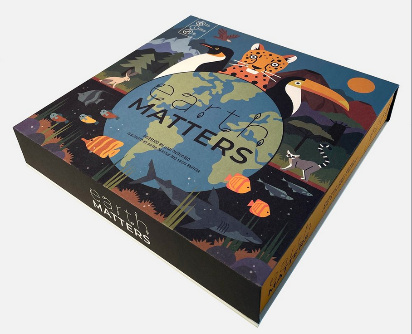How do you discuss a serious topic like climate change with children in a fun and age-appropriate way? With a board game, of course! “Earth Matters” is a board game for 2–5 players developed by a former art teacher that engages children in conversations about the causes, effects, and solutions to the climate crisis.

The game board is basically a giant graph with time on the x-axis and temperature on the y-axis. Scattered across the board are critical habitats and energy resources. When players land on one of these spaces, they collect tokens for points. To begin, players choose one of five animal pawns and a starting position on the left side of the board. As the game proceeds, they can move to the right (forward in time) as well as up and down (increasing or decreasing temperature). This is a fun and engaging way to introduce graphing to children. If a pawn reach- es the top row with the highest temperature, it becomes an endangered species; the player must return the collected tokens and start over. Habitat loss owing to increased temperature is a good, age-appropriate way to communicate the dangers of climate change to young children.
Game play is directed by a deck of cards with a range of different actions: some invite players to share their knowledge of nature or eco-friendly practices, some provide interesting facts about living things, and some register events. Events that are good for the environment, such as gardens growing on rooftops or solar panels installed on homes, earn a player points or move them toward a lower temperature. Events that are bad for the environment, such as burning fossil fuels or using disposable diapers, cause a player to lose points or move toward a higher temperature.
I played the game with my 12-year- old daughter in about 30 minutes. Although the game is marketed for ages 8 and up, it was too simple for her. She easily answered most of the questions and rolled her eyes at a couple of the silliest cards (one commanded her, “Howl like a wolf!”). Just a few years ago, she would have loved the chance to act out animals.
The game is probably best suited for 6–10-year-olds. Middle schoolers are excellent game reviewers because they excel at pointing out inconsistencies. For example, my daughter lost a point when she drew a card that said, “You just drank a sugary, caffeinated, carbonated, high-fructose corn syrup drink.” She objected, “That isn’t fair. That doesn’t have anything to do with the environment,” and certainly the card didn’t make the relevance clear. I was more bothered by the possibility that climate change deniers would interpret the soda card as just another example of a liberal agenda to control personal choices. But that was the only card that triggered that thought.
There were other game situations that bothered my daughter. One card said, “Five islands in the Solomon Is- land chain are underwater. The hot- test player may cool down three degrees.” It didn’t make sense to her that a negative effect of climate change would move a player down in temperature. I agreed with her assessment. Similarly, I noticed that the energy tokens worth the most points were fossil fuels. It seemed strange that the greatest reward went to the energy sources with the worst impact on the environment. But the fossil fuel resources are near the top of the board, which corresponds to higher temperature and greater risk of extinction, so perhaps it makes sense.
Other aspects of the game that annoyed my daughter actually turned out to provide teachable moments. For example, she drew a card that said, “Everyone remembers to vote. All players move one step.” She wondered out loud, “What does voting have to do with the environment?” I explained that candidates can have different ideas about how important it is to protect the environment and how we should go about doing it, and that how we vote is critical for addressing the climate crisis. Another time she was stumped to name four materials that are recyclable, so I had to give her a hint. As a mom and former science teacher, I count these lessons as major wins.
Overall “Earth Matters” is a cute game. The pieces are sturdy, the artwork is appealing, and I really liked how small shells and rocks served as game pieces. It is more educational than most board games for this age group that I’m familiar with, but I think it would be best played with an adult to guide the discussion. Since there are not suggested answers to the questions and the discussions stimulate questions about technology, voting, personal choices, and collective action, the best use of the game may be as a vehicle for discussing these important topics with children.







